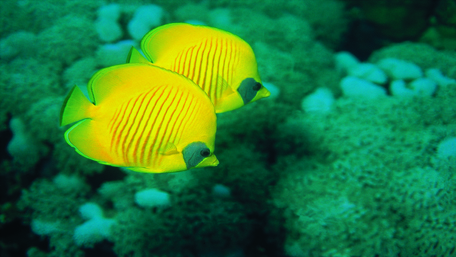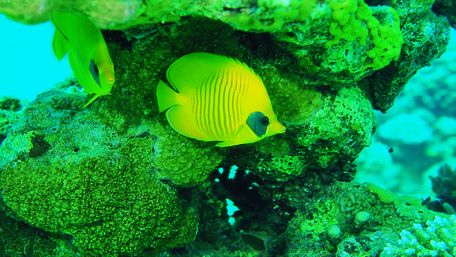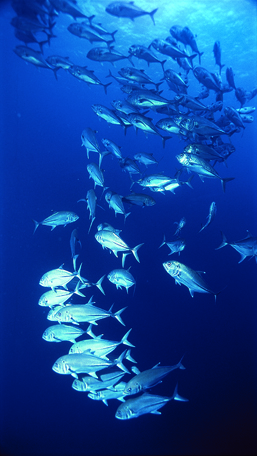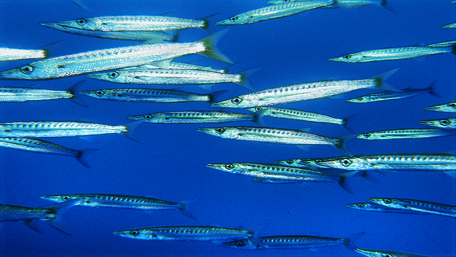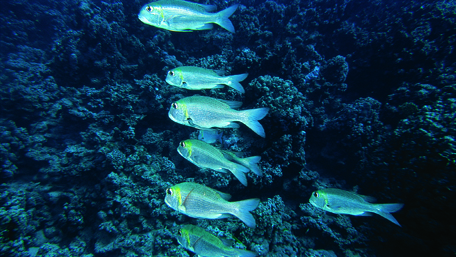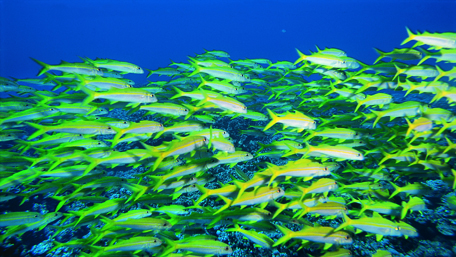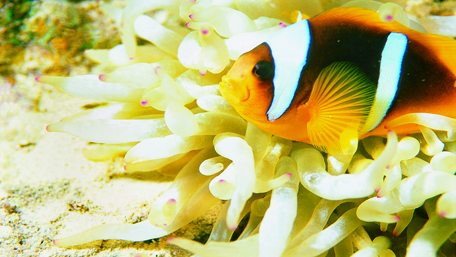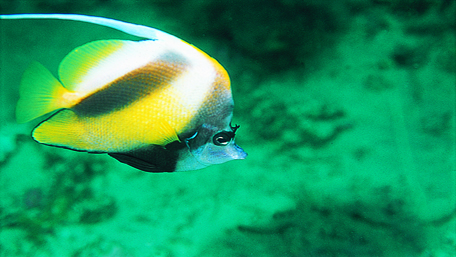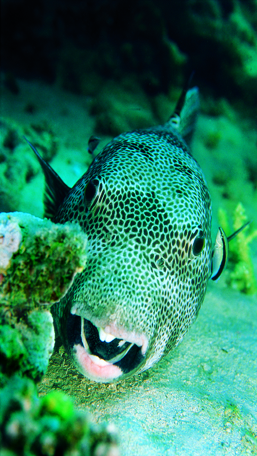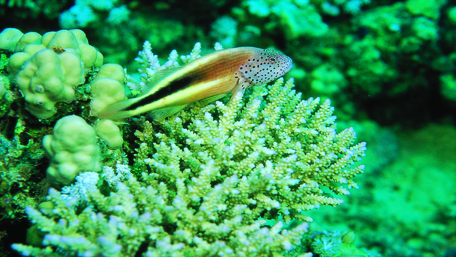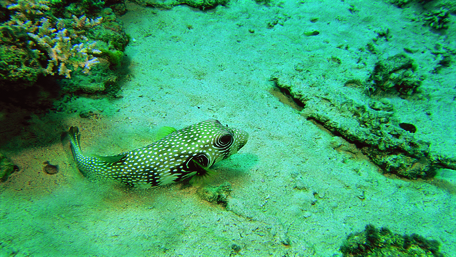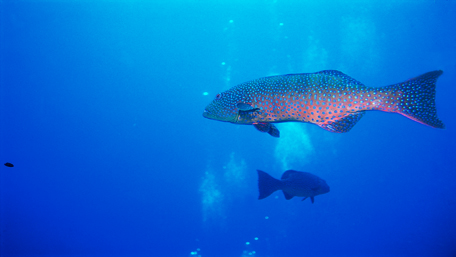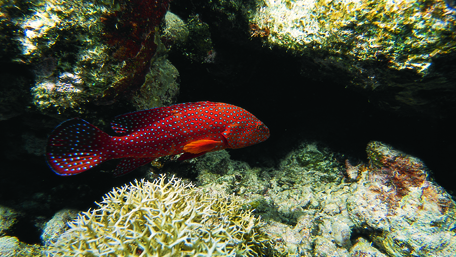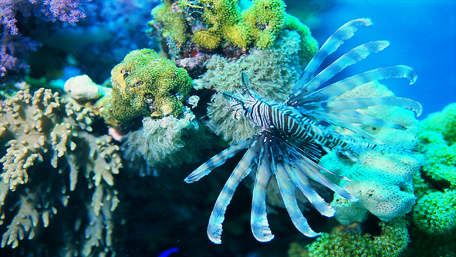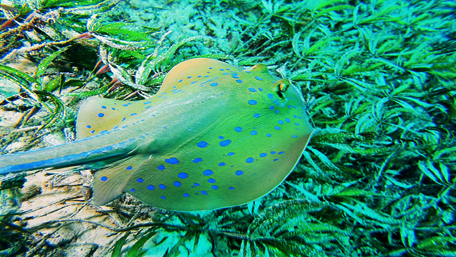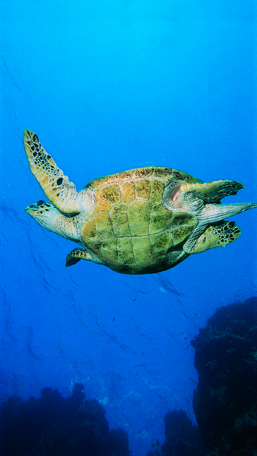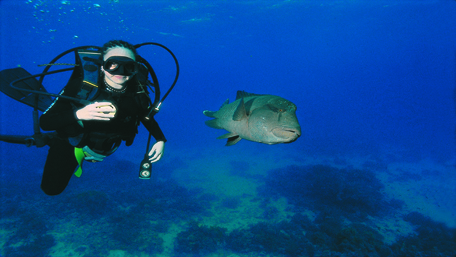Surprising, this fascinating and wonderful underwater world that hosts wildlife of extraordinary richness. Let’s discover these species of shapes, colors and with different ways of life.
© Prestige / Simon Nadim
The Sea Butterfly is one of the most recognizable species of the Red Sea with its yellow color that attracts divers. Living in pairs or groups, this fish is more active in late afternoon and eats coral polyps. The rest of the time, it hides safely under corals to avoid predators.
© Prestige / Simon Nadim
Bench of mackerel or big eye trevally. These fish live in groups of several hundred individuals in deep lagoons (up to 90m). Impressive sight: the sudden change of formation of the group, giving the spectator extraordinary shows. Mackerel move from one reef to another in search of food, small coral fish.
© Prestige / Simon Nadim
Blackfin barracuda is the most common in the region. 130cm long, it waits patiently for the sunset to go hunting for fish.
© Prestige / Simon Nadim
Living in small groups, bigeye emperors live in sandy areas of the Red Sea.
© Prestige / Simon Nadim
These mulloides vanicolensis or yellowfin goatfish (family of mullets) live in groups of two hundred. It is not uncommon to see them with other species such as snappers.
© Prestige / Simon Nadim
Amphiprion bicinctus, two band anemone fish or Nemo for short. Sole representative of the family of damsel fishes in the Red Sea, this clown fish hides in the tentacles of anemones that protect it against hungry predators. Despite its eleven cms long only, adult fiercely defends its territory.
© Prestige / Simon Nadim
The masked puffer belongs to the family of moonfish. At the slightest danger, it inflates its stomach bag to frighten intruders. Rather living alone, the arothron diadematus only joins large groups in periods of mating.
© Prestige / Simon Nadim
The Red Sea bannerfish, endemic to the Red Sea, like to swim along the coral reefs. They feed on plankton and small invertebrates. Do not be fooled by appearances, these fish are very territorial desperate to prevent intruders too curious to approach their “domain”.
© Prestige / Simon Nadim
Pufferfish
There are at least a hundred species. Some are equipped with a long “nose”, others with a rounded form, but all have beautifully colored skin. A real natural masterpiece.
© Prestige / Simon Nadim
The Foster’s hawk fish are widespread in the Red Sea and the Indian Ocean. They pick the little fish that have the unfortunate idea of leaving their groups and make a feast.
© Prestige / Simon Nadim
Measuring up to 1.20m, the puffer giant is the largest fish-moon. Despite its impressive measurements and its fierce predator look, this is a very shy fish, living alone in the quiet coral reefs.
The starfish of Egyptian sea or gomophia egyptiaca with its five branches covered with conical horns, is a nocturnal marine animal and an invertebrate predator.
© Prestige / Simon Nadim
Two species of the family of red grouper: the Red Sea coral grouper and the coral grouper. Up to 1.10 m in length, these fish live solitary in coral reefs and underwater wrecks, feeding on crustaceans and different varieties of fish including eels.
© Prestige / Simon Nadim
From the family of Pteroinae, so familiar, that lionfish can grow up to 40 cm long. Living alone or in community, these predators are armed with a powerful venom housed in their fins to defend themselves against the greatest. To all divers, these superb Pterois volitans often attack who dares to venture too close to them …
© Prestige / Simon Nadim
Sélicien fish of the genus Dasyatis, this viviparous ray has an extremely poisonous tail stinger. Blue spotted stingray one meter long, it enjoys itself with shrimps during the night, sea worms and crabs.
© Prestige / Simon Nadim
Hawksbill sea turtle, a veteran of the Red Sea. Older than the dinosaur, the sea turtle is endangered of all species and is listed on the IUCN Red List (International Union for Conservation of Nature). Leading cause of death: denaturalization of beaches where the females lay their eggs because of the hospitality and tourism development.
© Prestige / Simon Nadim
Napoleonfish or cheilinus undulates, recognizable by its size (2m30) and its bump on the forehead, to which it owes its name. Feeding mainly on molluscs, it is not uncommon to see it eat chicken eggs offered by divers. Hunted for its edible flesh, sold more than $ 100 per kilogram in the Far East, it suffered the most brutal fishing (dynamite and sodium cyanide) and is unfortunately endangered…
Report and Photos : Simon Nadim


